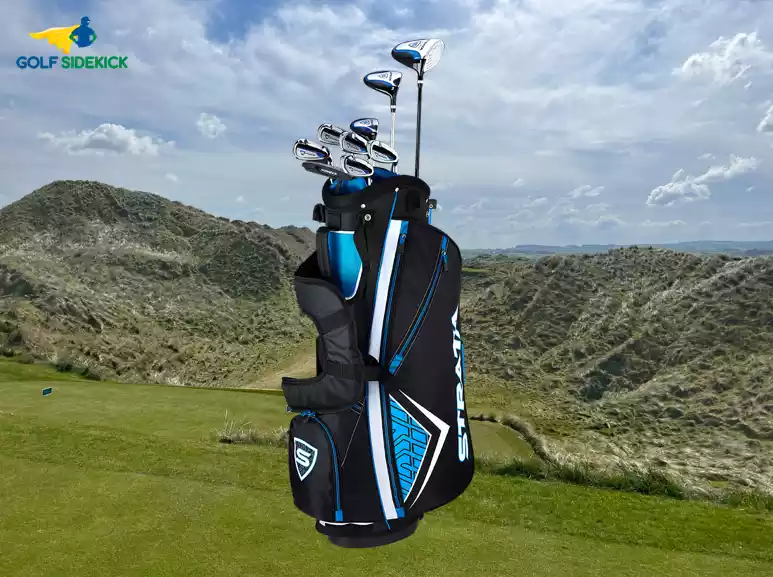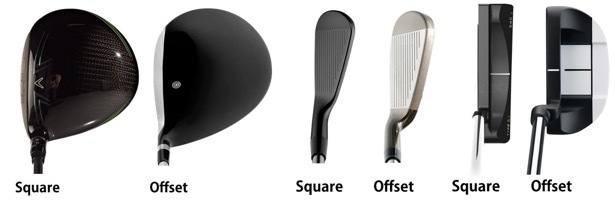Last Updated on January 27, 2024 by Matt Greene
*Read our review guidelines.
You're new to golf and that's the best time to be alive.
You’ve come to the right place! My mission is to help you find great clubs so you can enjoy golf quickly and play forever.
We'll take a look at the best beginner golf clubs, both complete sets and building your own bag, and I'll share some insights so you can make an easy decision so you can enjoy this game forever.
If you would like to save on the budget, look for the clubs listed here, second hand. That is always a good option as beginners for all equipment.
Best Beginner Golf Clubs in 2024
Complete golf sets for beginners
- Wilson Profile SGI Men's Set (best budget set)
- Callaway Men's Strata Set (excellent high lofted driver in the set)
- Prosimmon X9 V2 Taller players Set (best for players over 6 ft 2)
Drivers
- Wilson Dynapower (best value driver)
- Cleveland Launcher XL 12° (driver designed for forgiveness)
- Ping G430 Max (easiest driver in the world to hit)
Fairway woods
- Cobra Air X (best older model fairway wood)
- Callaway Rogue ST Max (widest range of lofts)
- Wilson Dynapower (most underrated fairway wood)
Irons sets
- Cleveland Launcher XL Halo (so easy to hit it's like cheating)
- Cobra Aerojet (most forgiving beginner irons)
- TaylorMade Sim Max (one of the best irons in the last 4 years)
Wedges
- Cleveland Smart Sole 4.0 - S Wedge (easy to chip and get out of bunkers)
- Cleveland CBX 2 Full Face - 56° Wedge (easiest to hit premium wedge)
- Ping Glide 4.0 - 56° Wedge (best wedge to keep in your bag a long time)
Putters
- Wilson Infinite putter (best feel and aiming in black color)
- Odyssey OG Series putter (best putter to keep forever)
- Cleveland Huntington Beach 4 Soft putter (best bang for buck putter)
Complete Golf Sets for Beginners
If you're looking for an all in one solution and don't need to think about it besides getting some balls and tees, the complete golf sets are perfect for you. My sister and my friend B-Dog on my Youtube videos started golf with complete sets and my sister still plays hers after 6 years!

The Wilson Profile is a ten piece set with all the essentials.
Very forgiving driver
Fewer clubs so you don't feel over analysis paralysis.
There are multiple options for this set. Players over 6'2 are encouraged to go for the 'LONG' set.

The Callaway Strata set has a perfect high loft driver for a beginner.
There are multiple sets to choose from but I really do recommend going with as few as possible.
The 14 piece set includes a sand wedge.
Easy to aim mallet putter.
Remove the 3 wood and don't hit it. Use the 5 wood.
*For golfers 6'2" and under

The Prosimmon X9 +1 is for the taller player over 6'2".
Includes two hybrids.
Five iron down to pitching wedge.
A large mallet putter is included.
There is no Sand Wedge
For golfers 6'2" and over
Drivers for beginner golfers
As a beginner you will love the confidence you get from a big driver head (460cc) with a big wide face to hit the ball with.
The big head gives us more forgiveness since there is more surface area to make contact with the golf ball.
To give us even more forgiveness, a beginner driver should have 11° to 14° degrees of loft. This will get the ball airborne and stay in the air longer. The higher loft also makes it easier to hit it straighter by giving us more backspin.
A a new golfer, you should try find used equipment where possible.
Understand golf club terminology
As a beginner or new golfer, you will encounter some jargon and golf lingo. It can get complicated and confusing when you read words you don't understand so here is a basic rundown of the terms you will see in golf club reviews.
- Adjustable – Some fairway woods and drivers and hybrids come with a wrench to adjust the club. You can make the ball go higher or lower bu adjusting the club when you unscrew the head from the shaft and place it in different settings.
- Bounce – When you put a sand wedge on the ground, the sole touches the ground (the bottom point) but the leading edge is raised above that bottom point. The angle between the bottom point and the leading edge is the bounce.
- Center of gravity (COG) - The is the exact spot on the clubhead where all balance points intersect. The placement of thecenter of gravity can make the ball go higher or lower.
- Draw Bias –Some golf clubs are designed to eliminate a slice or fade by specially designing the club to turn the ball right to left. The manufacturers place weights in certain parts of the club to adjust the tendency of the ball to go right or left.
- Fade or Slice - When you hit a ball and it moves left and then moves even further to the right, very far away from where you intended.
- Forgiveness – We talk about more forgiveness in a club when you do not hit the ball perfectly but the club helps you get a better result than you expect from the bad hit.
- Hook - When you hit a ball and it moves left and goes further left
- Loft – The angle between the golf club face and the ground at address. More loft produces higher shots. Lower loft produces lower shots.
- Length – This is the length of the golf club including the shaft and where it enters into the club head.
- Offset - This is where the leading edge of the club is set behind the shaft, not in line with the shaft. This helps to square the club face for new golfers and also promote right to left ball flight.
- Perimeter Weighting – Manufacturers make a cavity in the back of the iron and move that excess material onto the perimeter of the club to make the perimeter stiffer but the club face more flexible for more distance and forgiveness.
What Clubs Should a Beginner Carry?
Above we said the best clubs for beginners are forgiving, but let's dig deeper into what forgiving means.
- Forgiving clubs have offset heads - the face is a little bit behind the shaft to allow the face to be square at impact

- Forgiving clubs have larger clubfaces - this increases the striking area, increasing the chance of actually hitting the golf ball
- Forgiving clubs have larger sweet spots - this allows you to get good distance even when missing the center of the club face.
- Forgiving irons have the weight of the club head distributed around the perimeter of the back of the club and a hollowed out back to get more weight behind your shot. These clubs are are called Cavity Back and are the easiest to hit.
Clubs to Avoid as a Beginner
Blade irons
Blade golf clubs from Jack Nicklaus days as well as modern blades are strictly for players who can hit the center of the club face 7 out of 10 times or more.
The back of the club is solid and gives the look of a knife blade.
The sweet spot is tiny and missing it results in actual physical pain throughout your hands and arms.
Let's go easy on ourselves in the beginning of our golf journey and play the most forgiving irons around.
Any wedge above 58 degrees of loft
The amount of skill needed to use the 60 degree wedge is very high.
It's a technical club that will take hours and hours of practice to get right. The 56 or 58 degree wedge is all you will need for a very long time in golf. Levae the low wedge 60 degree for the scratch players and pros.
The Easiest Clubs from the Fairway for Beginners
Generally beginners have longer shots into the greens while learning the game. Long irons are probably the most difficult club in the bag for new players to master.
Fairway woods and hybrids take their place and are extremely easy to hit and forgiving because they have more mass behind them to get the ball airborne and going straight than irons.
Luckily manufacturers are targeting the beginner and higher handicap group of players with awesome fairway woods and hybrid clubs. They take the place of 2, 3, 4 and even 5 irons in the set, making mid to long distance approaches easier than ever.
But don't think these clubs are only for long approaches. You can also use these clubs and SHOULD use these clubs to get the ball in the fairway off the tee when starting out at golf. It's satisfying hitting one big bomb drive per round, but shooting a good score is far more satisfying after the round by playing conservatively with fairway woods and hybrids off the tee.
Check out our fairway wood and hybrid guides for high handicappers for some ideas on suitable clubs.
The Most Fun Irons for New Golfers
There are a few buzzwords you hear in the golf world when researching clubs. Super Game Improvement and Game Improvement are two popular ones at the moment.
The basic idea behind a Super Game Improvement iron is that it is aimed at rapidly improving your game as a beginner or high handicapper by using the most forgiving technologies available. Check our guide for the best clubs for beginners.

Can you spot the cavity back, perimeter weighting and wide sole?
Technology used to produce forgiving iron golf clubs for beginners
- Cavity back: they hollow out the back of the club to make the face thinner and in turn causing the ball to rebound quicker and travel a longer distance
- Perimeter weighting: They take that hollowed out material in the cavity back an distribute the weight all the way around the outside edge at the back of the club to give more weight behind all your shots regardless of where you hit it on the face.
- Wide soles with low center of gravity: These prevent digging into the earth and instead make the club glide over the turf to get under the ball and produce a much higher ball flight.
The Best Putter for Beginner Golfers
Alignment is key for good putting. Get that part hacked and all you need to do is work on the feel of hitting it the right distance. You're going to be three-putting quite a lot in the beginning of your golf career, but it gets better with time.
Having a putter that has a little offset to keep your hands in front of the ball is ideal. This promoted a forward roll of the ball instead of a skidding hit up into the ball with hands behind it. The mallet patter is easy to align with the lines on the back of the club.
Check out our putters for beginners guide to get some budget ideas for decent putters.
The Best Sand Wedge for Beginner Golfers
Beginner sets often don't come with a sand wedge and you might like to have one for escaping the bunkers. In fact, I'd say if your set doesn't have one, you must get one to have some fun chipping and pitching onto the greens.
We're looking for sand wedges that give us a lot of forgiveness. Big bounce and a wide sole is essential for a forgiving sand wedge. The best type of sand wedge for a beginner is one with 56° to 58° of loft with a minimum of 10° of bounce.
Check out our Wedges for Beginners article to learn more about bounce and wide soles and forgiving wedges. I've found only the best for your game.
The verdict: Best Golf Clubs for Beginners
The best golf club set for beginners is the Wilson Profile Men's Set. It has everything you will need in terms of clubs to gets started in the game, and will last you for many years and rounds of gold due its quality.
You can build your own set with some good choices, either with individual irons one at a time, settling on a partial set to play the game with or go for a new set of irons from a good manufacturer. As a beginner, you want to invest in a set that will make golf fun immediately and easier on you.
The beginner sets are good value but will one day need to be upgraded. You might be tempted to buy what the pros are playing because you see them on TV. They are some of the best golfers in the world and beginners should be starting off really easy and simple to gain confidence to move through the ranks.You may one day be a professional. But let's start off at the right spot.

